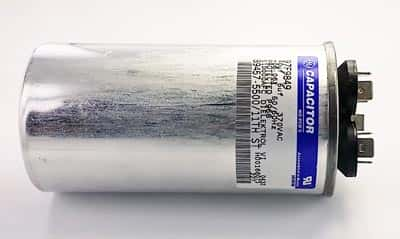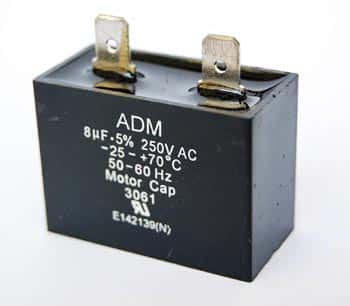Electric motors exploit the interaction between two magnetic fields for rotating a shaft. The stator windings generate one of the fields, and the rotor windings provide the other. In some DC motors, permanent magnets replace one of the windings, while the commutator, whether brushed or brush-less, changes the direction of the current in the other winding to continuously alter the interaction between the two magnetic fields to allow the motor to rotate.
In three-phase AC motors, the interaction between the three incoming phases creates the rotating magnetic field in the stator windings, and this pulls the rotor along, making it rotate. The so-called single-phase AC motor is, in reality, a two-phase AC motor that is operated with a single-phase supply, with capacitors generating the second phase. These motors require two capacitors, one to start the motor, and the other, to keep it running.
A capacitor is a device to store charge. In the DC circuit, a capacitor will charge up and stay that way until allowed a path to discharge. In the AC circuit, where voltage and current change polarity regularly, the capacitor charges up to the peak voltage in one cycle, then discharges and again charges up to the negative peak in the next cycle, with the rate of charging and discharging dependent on the capacitor value and the impedance in the circuit.
Another important factor is the voltage on the capacitor does not follow the input voltage while it is charging and discharging—it lags behind. Even though the supply voltage may be at its peak, the voltage on the capacitor reaches the peak only after the capacitor charges. Likewise, as the supply voltage moves towards the negative peak, the capacitor voltage follows more slowly as the capacitor has to first discharge. This lag helps to create the second phase for the motor.
A motor starting from rest requires a high starting torque, but once it has started moving, requires a smaller running torque to keep it in rotation. That means a larger capacitor is necessary for starting the motor—providing it with a larger starting current. In fact, motors use a centrifugal relay to cut out the start capacitor from the circuit after the motor has reached a certain speed. The run capacitor, though, has to remain connected to the motor at all times.
As the run capacitor is engaged in the circuit continuously, they are oil cooled and in metal, cases to allow heat dissipation. As they face peak to peak voltages all the time, their voltage rating tends to be on the higher side—typically, 1.5 times the line voltage, although the capacitance value may be low, ranging between 5 µF and 45 µF. On most 240 V systems, run capacitors are likely to be rated 370-440 VAC, and in 480 V systems, 600 VAC capacitors are more common. Run capacitors are rated for 100% duty cycle.
Start capacitors, being of larger capacity, are physically larger as well. As the start current does not need to be very precise, start capacitors are available as 8.3 µF, 15 µF, 43 µF, 60 µF, and above. Common voltage ratings for start capacitors are 110, 125, 165, 220, 250, or 330 VAC.


